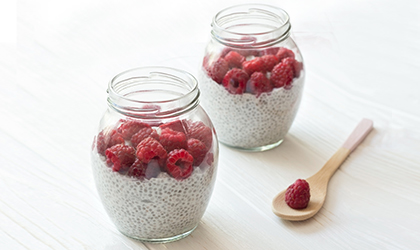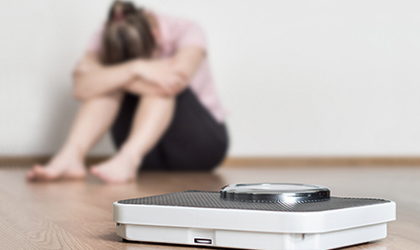
Waist-slimming. Mood-boosting. Gut-loving. Say hello to the ‘jack-of-all-trades’ in the nutrient world: fibre. Fibre is a type of carbohydrate that helps food pass through your digestive system. By slowing down the pace of digestion, it increases the absorption of nutrients and provides your body with a steady release of energy. The rough stuff is responsible for revving up your metabolism, torching more calories, keeping your body balanced and supporting gut health. In short, it’s essential for staying slim, strong and healthy.
Why is fibre so important?
Digestive health
Snigger all you like, but eating enough fibre will help you be more, well, ‘regular’. Constipation is a very common complaint in the United Kingdom i. And, let’s not beat around the bush here: it’s no fun at all. Dietary fibre makes your stools bulkier and softer, meaning they’re much easier to pass from your body. Better still, fibre naturally promotes the elimination of nasty toxins from your digestive tract. And the faster these harmful chemicals pass through your body, the less likely they are to do any damage. Forget those restrictive juice cleanses – just up your intake of fibrous goodness instead.
Support gut bacteria
Fibre bolsters the colonies of good bugs in your colon and digestive tract. In 2017, a study found that a well-rounded fibrous diet is intimately linked to optimal gut health ii. It literally feeds the live bacteria in your gut, helping them thrive and work their magic. Supporting your microbiome can nourish your emotional wellbeing, too. Really – research suggests happiness and gut health go hand in hand iii. But that’s not all; gut health also supports your immune defences. Did you know 70 to 80 per cent of your immune tissue is located in the digestive tract? Keeping sickness at bay is just another reason to eat more fibre.
Weight management
One piece of advice that’s more helpful than counting calories, following strict diet plans and meticulously measuring portions put together is – yup, you’ve guessed it – eating more fibre. A study published in the Annals of Internal Medicine suggests filling up on around 30 grams of fibre every day could support weight loss iv. Indeed, the investigation revealed the fibre-eating group shed nearly as much weight as the control group who followed a much more rigorous diet – one that limited sugar, fat, salt, and increased wholegrain, veggie and fruit consumption. The funny thing is fibre doesn’t boast any fat-burning credentials per se; it merely helps you feel full without loading up on extra calories. The satiating and slow-release energy properties of fibrous food make them a perfect option for breakfast, a mid-afternoon pick-me-up, or as a pre-workout nutrition.
How much fibre do you need?
To reap the benefits of fibre, you should aim to eat 30 grams every day v. Embrace a variety of fibre-rich fruits, veggies, nuts, seeds and the foods we’ve outlined below. Oh, and as you increase your fibre intake, you may want to guzzle more water to prevent stomach upsets. Set yourself the target of drinking eight to nine glasses of H20 every day.
Fibre-rich foods
Legumes
Legumes come in all shapes, sizes, textures and colours – its what makes them so charming. Peas, dried beans and lentils all belong to the nutrient-dense family, and are amongst the most nourishing foods you can eat. Not only are these beauties chock-full of fibre to keep your digestive system happy and healthy, but they’re also rich in protein, making them a super satiating option for meals. These fellas are kitchen all-stars, working wonders at bulking out soups, salads, casseroles, and dahls.
Broccoli
If you want to up your fibre intake, look no further than this verdant veggie. Versatile, delicious and brimming with nutrients, this cruciferous vegetable deserves a place at almost every meal, packing 2.4 grams of fibre per 100 gram. But broccoli doesn’t only tend to your fibre needs; it’s crammed with tons of folate, B vitamins, potassium, iron, and vitamin C and K, too. Plus, it’s relatively high in satiating protein. Munch on this veggie raw, steam with a dash of sea salt, or roast with plenty of garlic and fresh rosemary.
Artichokes
Delivering the most fibre in the vegetable kingdom, it’s a wonder why artichokes haven’t dominated the health headlines more. Underneath that prickly exterior, artichokes contain an impressive 10.3 grams of fibre per 100 grams. There are many ways you can enjoy its delicious flower buds, pairing perfectly with salads, pasta, soup, or risotto. Heck, you could even go the whole hog and make your own artichoke fritters, which are – we might add – a tasty vegan alterative to battered fish.
Avocados
Few foods truly earn their stripes as a ‘superfood’ more than the humble avo. Supplying 6.7 grams of fibre per half avocado, this creamy, velvety, buttery fruit will nourish your digestive system as well as complementing a host of dishes: sandwiches, salsas, smoothies, and salads – the list could go on. Plus, these green guys are brimming with vitamin E and C, potassium and healthy fats, too. There’s no reason not to inject a little more avo goodness into your diet.
Porridge
Porridge is the tried-and-tested breakfast of kings. Did you know half a cup of cooked oats contains 5 grams of fibre? Yup, eating a warming bowl of porridge is one of the best ways to jumpstart your day. Its impressive fibre credentials won’t only stimulate your digestive system, but it will keep you satisfied and energised till lunch (goodbye mid-morning cravings). Better still, it’s jam-packed with tons of protein, making it an even more satiating option. Porridge is a brilliant canvas for seeds, berries, and spices. Is there really a better breakfast food?
Chia seeds
Traditionally heralded for their rich omega-3 fatty acid content, chia seeds also pack a potent hit of fibre. Don’t be fooled by their small size, these little guys contain 5.5 grams of the rough stuff per tablespoon, making them one of the best sources of fibre on the planet. The real beauty of chia seeds is their versatility; you can add them to smoothies, salads or baked goods. Oh, and for a double whammy of fibrous goodness, why not add a sprinkling to your morning bowl of porridge? Why not try making chia seed pudding or having a go at making your own easy chia seed jam!
Brown rice
This list wouldn’t be complete without a mention of our trusted friend, brown rice. One cup of cooked rice serves up a delicious 4 grams of fibre to nourish your digestive system, gut health and waistline. Plus, it has low GI credentials (the rate at which your body processes and digests carbohydrates), meaning it won’t spike your blood sugar levels and run your energy stores dry. Brown rice is the brilliant base for the voguish Buddha bowl or as a side dish to curries, fish or meat.
Kale
No, kale’s moment isn’t over just yet. This leafy green veggie delivers almost double the amount of fibre found in spinach, with approximately 1.3 grams in one cup. It’s also rich in the vitamins A, C, K, folate, and protein. If straight-up kale isn’t your thing, try making kale chips by roasting a handful with olive oil, sea salt and cumin. Another simple way to get your fix is by throwing a serving in your morning smoothie. Bonus: green drinks are a delicious way to nourish the body first thing in the morning.
Pears
Craving a sweet ‘je ne said quoi’? Look no further than a juicy pear. One raw pear alone packs 9 grams of fibre. Impressive or what? Pears are also loaded with antioxidants, vitamin C, potassium, magnesium, iron and calcium. Poached, grilled, or raw – pears taste utterly divine every way. And if you’re feeling especially indulgent, pair your pear with a little blue cheese. Mhmm…pure culinary ecstasy.
References:
-
nhs.uk. (2018). Constipation. Available online: https://www.nhs.uk/conditions/constipation [Accessed 8 Nov. 2018].
-
Zou, J., Chassaing, B., Singh, V., Pellizzon, M., Ricci, M., Fythe, M., Kumar, M. & Gewirtz, A. (2018). Fiber-Mediated Nourishment of Gut Microbiota Protects against Diet-Induced Obesity by Restoring IL-22-Mediated Colonic Health. Cell Host & Microbe, 23(1), 41-53.e4.
-
Hadhazy, A. (2018). Think Twice: How the Gut's "Second Brain" Influences Mood and Well-Being. Scientific American, Available online: https://www.scientificamerican.com/article/gut-second-brain [Accessed 7 Nov. 2018].
-
Ma, Y., Olendzki, B., Wang, J., Persuitte, G., Li, W., Fang, H., Merriam, P., Wedick, N., Ockene, I., Culver, A., Schneider, K., Olendzki, G., Carmody, J., Ge, T., Zhang, Z. & Pagoto, S. (2015). Single-Component Versus Multicomponent Dietary Goals for the Metabolic Syndrome. Annals of Internal Medicine, 162(4), 248.
-
British Nutrition Foundation, (2018). Dietary fibre. Available online: https://www.nutrition.org.uk/nutritionscience/nutrients-food-and-ingredients/dietary-fibre.html [Accessed 9 Nov. 2018].
You Might Also Like

Keri
Keri Filtness has worked in the Nutrition Industry for 19 years. She is regularly called upon for her professional comments on health and nutrition related news. Her opinions have been featured by BBC3, Prima, Vitality, The Mirror, Woman’s Own and Cycling Weekly, amongst others. She has also worked one to one with journalists, analysing their diets and health concerns and recommending changes and additions, where appropriate.
View More






